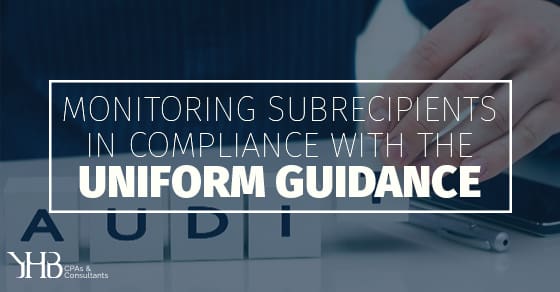The Compliance Supplement, published by the Office of Management and Budget, identifies 12 types of compliance requirements that may or may not applicable to a federal award(s) provided to a non-Federal entity. One of the requirements that may be applicable to a non-Federal entity is that of subrecipient monitoring.

In order to understand the compliance requirement of subrecipient monitoring, it is helpful to be familiar with what constitutes a subrecipient vs. a subcontractor. An agreement with a subcontractor establishes a procurement relationship, whereby the subcontractor performs services or provides goods to the non-Federal entity. On the other hand, the goal of a subrecipient is to assist the non-Federal entity (the pass-through entity) with carrying out the federal program.
If the determination has been made that a vendor is in substance a subrecipient, there are certain requirements included in the Uniform Guidance. In the creation of the subaward, the agreement between the pass-through entity and the subrecipient must identify the federal award, including the period of performance, CFDA number, funds obligated and committed, program description and indirect cost rate applicable to the award.
The pass-through entity must also evaluate the risk of noncompliance of the subrecipient. This evaluation assists the pass-through entity in determining the level of monitoring required of the subrecipient. In evaluating the risk of noncompliance, it may be helpful to assess the prior experience with the subrecipient, results of single audits, and/or personnel or systems involved with the subaward.
Monitoring a subrecipient consists of reviewing financial and performance reports, the results of single audits and following up on any audit findings identified. If the pass-through entity determines a higher risk of noncompliance, on-site reviews or training and technical assistance may be necessary. The pass-through entity also has the option for higher risk subrecipients to require more detailed reports and/or payments made as reimbursements instead of advances to the subrecipient.
Ultimately, the pass-through entity, through its monitoring procedures, must ensure compliance with the Federal statues, regulations and terms and conditions of the Federal award.
The Compliance Supplement, along with the agreement for the federal award(s), are helpful tools to determine if subrecipient monitoring is applicable to a federal award(s) received by a non-Federal entity. If it is determined that the non-Federal entity must comply with the requirement of subrecipient monitoring, the Compliance Supplement not only provides a summary of the requirement but also references the section of the Uniform Guidance that guides the requirement.
Stay tuned for our next article in the series focused on Uniform Guidance compliance audits.
READY TO TALK TO AN EXPERT? CONTACT OUR NOT-FOR-PROFIT & GOVERNMENTAL SERVICES TEAM.
About the Author
 Since joining YHB in 2012, Katrina’s career focus has been on nonprofit organizations such as private schools, colleges, foundations, religious organizations, museums, and other nonprofit entities. Her service to those organizations include audit and attest as well as tax services.
Since joining YHB in 2012, Katrina’s career focus has been on nonprofit organizations such as private schools, colleges, foundations, religious organizations, museums, and other nonprofit entities. Her service to those organizations include audit and attest as well as tax services.

